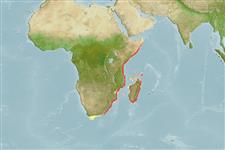>
Ovalentaria/misc (Various families in series Ovalentaria) >
Ambassidae (Asiatic glassfishes)
Etymology: Ambassis: Derived from Greek, anabasis = climbing up (Ref. 45335).
More on authors: Gilchrist & Thompson.
Environment: milieu / climate zone / depth range / distribution range
Οικολογία
Θαλασσινό(ά); Γλυκού νερού; Υφάλμυρο βενθικό(ς). Subtropical; 13°N - 39°S, 19°E - 52°E
Western Indian Ocean: East coast from KwaZulu-Natal south to Algoa Bay in South Africa (Ref. 4318, 7248, 52193). Reported from east Africa (Ref. 4318), including Madagascar (Ref. 4180, 50956) and Mauritius (Ref. 50956).
Length at first maturity / Μέγεθος / Βάρος / Age
Maturity: Lm 3.5 range ? - ? cm
Max length : 10.0 cm SL αρσενικό/απροσδιόριστο; (Ref. 52193)
Short description
Κλείδες προσδιορισμού | Μορφολογία | Μορφομετρία
Ραχιαίες άκανθες (συνολικά) : 8; Μαλακές ραχιαίες ακτίνες (συνολικά) : 9 - 11; Εδρικές άκανθες: 3; Μαλακές εδρικές ακτίνες: 9 - 11. Diagnosis: Ambassis natalensis has following combination of characters: supraorbital spines 1-4; rostral spine absent; rear margin of preopercle entirely serrate; preopercle ridge smooth except for 1-5 tiny spines at rear corner; interopercle smooth or with 1-4 tiny serrae at angle; two rows of cheek scales; predorsal scales 9-11; lateral line continuous; lower gill rakers 19-22; pectoral-fin rays 14-15; teeth on vomer and palatines in 2-3 rows (Ref. 50956).
Tolerant of freshwater within a temperature range of 19-27°C (Ref. 4180, 52193, 79840). In summer, it feeds mainly in early evening and late morning while in winter, it feeds both day and night on crustaceans as well as insects (aquatic and terrestrial) and fish (Ref. 7248, 52193). Excellent subject for biological research as it easily thrives in captivity (Ref. 12484).
Life cycle and mating behavior
Γεννητική Ωρίμανση | Αναπαραγωγή | Γεννοβολία | Αβγά | Γονιμότητα | Προνύμφες
Maugé, L.A., 1986. Ambassidae. p. 297-298. In J. Daget, J.-P. Gosse and D.F.E. Thys van den Audenaerde (eds.) Check-list of the freshwater fishes of Africa (CLOFFA). ISNB, Brussels; MRAC, Tervuren; and ORSTOM, Paris. Vol. 2. (Ref. 4180)
IUCN Red List Status (Ref. 130435: Version 2024-1)
Threat to humans
Harmless
Human uses
αλιεία: χωρίς ενδιαφέρον; Ενυδρείο: Εμπορικό(ά); δόλωμα: usually
Εργαλεία
Special reports
Download XML
Διαδικτυακές πηγές
Estimates based on models
Preferred temperature (Ref.
123201): 23.9 - 27.6, mean 26.7 °C (based on 82 cells).
Phylogenetic diversity index (Ref.
82804): PD
50 = 0.5000 [Uniqueness, from 0.5 = low to 2.0 = high].
Bayesian length-weight: a=0.01413 (0.00731 - 0.02730), b=3.02 (2.85 - 3.19), in cm total length, based on LWR estimates for this species & Genus-body shape (Ref.
93245).
Τροφικό Επίπεδο (Ref.
69278): 3.4 ±0.59 se; based on food items.
Ελαστικότητα (Ref.
120179): Υψηλό, ελάχιστος χρόνος για διπλασιασμό πληθυσμού < 15 μήνες (Assuming Fec > 10,000).
Fishing Vulnerability (Ref.
59153): Low vulnerability (10 of 100).
